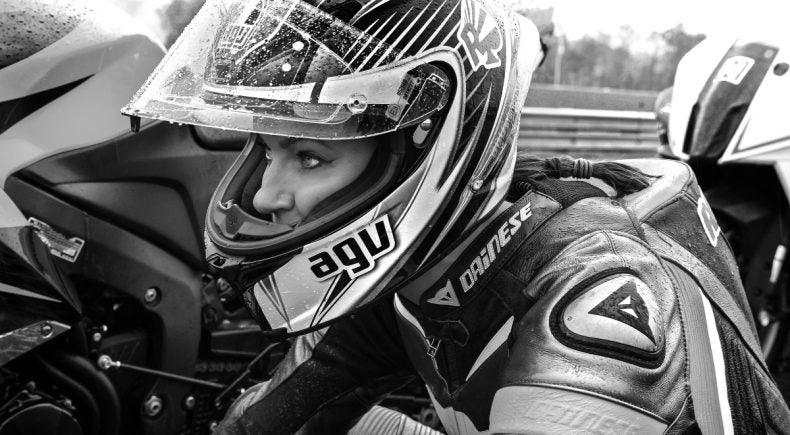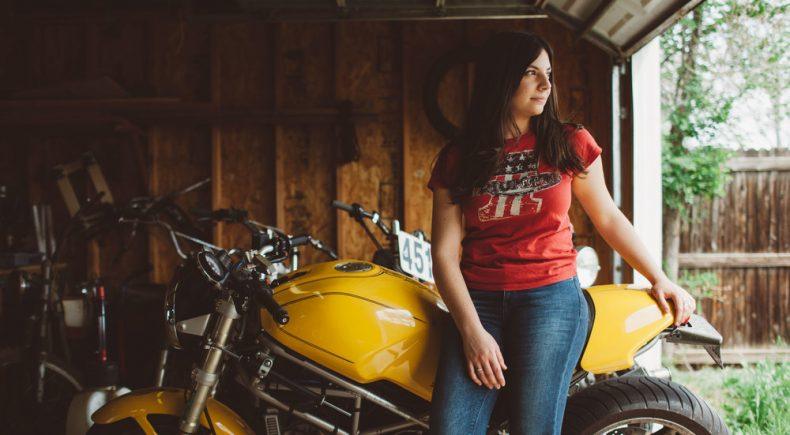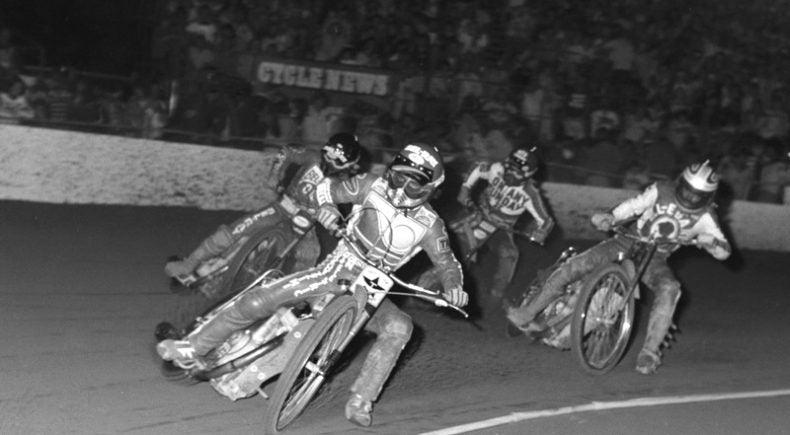
Photo courtesy of 129 Photos.
Anna Rigby is the Founder of RedSpade Racing, a motorcycle community and cultural hub on social media. By weekday, she works as a graphic designer based out of Georgia. By weekend, she’s a trackday warrior and boots-on-the-ground motorcycle community pillar. In the interview, she discusses how RedSpade started as the origin of #motoporn, and grew into a cultural hub where hundreds of thousands of riders come to share their individual experiences and grow as a community on the same journey.
British Customs: How did you start riding?
Anna Rigby: I honestly never thought I would ride. My husband and his entire family rode, and a few of them were into road racing. Five years ago I went with my brother-in-law to watch a race, and I fell in love with the atmosphere. Up until that point, I had only seen street riding, never anything on the track, but after seeing how they rode and the camaraderie they shared, I decided I had to do it myself.
I never saw women racing on the track, and I honestly didn’t think women could ride like that. I started riding pillion with my husband, and I met a female rider at Deals Gap. She was killing it out there, and when I talked to her she told me I could ride just as well as she did. I told her I didn’t believe her, especially since I had no riding experience at all. But she told me to take an MSF course, learn how to ride, tip some bikes to get over the fear of dropping a bike, and just get out there and do it. It took me about a month to gather the courage I needed to do the course, and the course was the most intense thing I had ever done physically and mentally, but it was a life-changing event. But I knew that if I didn’t do it now, it wasn’t going to happen.
I passed the MSF, and the following weekend went and bought my first bike: a CBR250. I have neuropathy in my legs, so I needed something light, small, and not too powerful so that I could learn to handle it. When I learned how to ride, I couldn’t actually physically upshift with my toes for about eight months, so I learned how to shift by using the heel of my racing boot. At one point in my life, my neuropathy was so bad that I was pretty much bedridden for two months; riding gave me back some normalcy. I could feel the wind in my face and get out and live. My passion for riding is due to that: it pulled me out of depression and gave me purpose again in life: being on a bike is one of the only times that I feel fully alive.
BC: What inspired you to establish RedSpade Racing?
AR: I was into photography, and I loved shooting motorcycles. RedSpade began as an Instagram account, and I actually started the hashtag #motoporn there. It was a social experiment at first, and within a year the motorcycle community really filled out on social media. I started going to races and shooting riders when no one was doing that on social media yet. And I posted a lot. Which is what helped it take off.
My husband bought a Blackbird because it’s a comfortable two-up bike, and we posted a lot about our rides and got really excited about it. I wanted to go riding all the time, but my husband started pushing me towards learning how to ride for myself. When I started riding, the channel grew from #motoporn to my personal journey as a motorcyclist. My husband always wanted to get out there and race, so we established RedSpade Racing just for fun. It grew into something beyond a hobby, and so we turned it into a company. And that company grew into a community when I started focusing not only on my journey but using RedSpade as a way to reach out to other racers and share their journeys.
When you have that one person who comes up and says something nice about how you shared something they did, it makes you feel untouchable.

Photo courtesy of Steve Rigby.
BC: RedSpade has a commitment to sharing the stories and experiences of the motorcycle community. What does the community mean to you?
AR: The motorcycle community is my family. I come from a very small family, and my parents divorced five years ago, which is when my father walked out of my life. It’s very sad to me because he’s a gearhead. I was very girly as a child and wouldn’t ever go into the garage; but now I do everything I can on my bike, and there’s this weight of the realization that I miss him. I’m probably more the daughter he wanted now than when he was around.
I think people that ride all experience the same sort of awakening, and gain a different understanding of life from it.
I’ve only had my track family for two or three years, but they’ve been amazing friends. The camaraderie is incredibly strong. They’ve become better friends than a lot of the people I’ve known for a very long time. I’ve become more community-conscious because of the friendships I’ve created, and thanks to these people I’ve met, I’ve become a part of a greater social circle, and it makes me feel more human. The track racing community is very supportive and tight. Every track day I go to there’s always someone there that takes me under their wing and teaches me something.
BC: What do you think it is about motorcycles that brings people together?
AR: It wasn’t until I got on the track that I started feeling that certain sense of freedom and elation from the realization of what I was actually doing. Racing on the track is so exhilarating and so dangerous, and when I go back to work after a weekend at the track, my coworkers tell me they think I’m crazy and they just can’t comprehend it.
It’s different than an adrenaline rush, and it takes a certain kind of person to enjoy that, and who seeks that. I think that’s why bikers understand each other and form such deep bonds. It’s almost like a spiritual connection. It’s a personal awakening. Life starts at the end of your comfort zone. I learned that the hard way: I hate being pushed out of my comfort zone. And everything about riding pushed me out of my comfort zone. It’s liberating. I’m very introverted, and when I started riding I felt incredibly awkward at red lights because I wasn’t in the protective bubble of a car to the point where I had to wear a smoked visor. Riding helped me ease into being more social step by step because of how all-embracing and welcoming the community is.

Photo courtesy of 129 Photos.
BC: On your website, you talk about sharing “The Rider’s Journey.” What is “The Rider’s Journey,” and why do you think it’s important to share that with other riders?
Out there, none of the petty things matter: it’s just you and your machine.
AR: To me personally, it’s the quest for self-betterment. When I took on riding, I didn’t know a damn thing about it. The people I learned with were leaps and bounds ahead of me, but you have to remember that racing a progressive sport: there’s always someone faster and you can always learn more. When I started on a 250, I faced a lot of opposition and abuse, and it made me determined to get good on a 250 and then get on a big cc bike and kick ass. Sharing that journey of growth, I helped inspire other riders along their journey to do the same thing. Racing is all about skills. I want to progress as much as possible for as long as I can do this. This sport is extremely dangerous, it’s almost ridiculous. And that’s very sobering. But it’s been a huge source of personal growth for me: I used to be very introverted and scared of everything until I started riding, but not anymore. I learned that you have to find something that you love and that makes your heart happy, and just do it.
BC: It’s interesting you note that we should share not only the highs but also the lows of our experiences as motorcyclists, which admittedly can be very low. Why do you think it’s important to acknowledge the bad things as well as the good?
AR: To enjoy the highs we have to have the lows: being bruised and put in your place and being humbled is how we learn and grow. It’s okay to have lows, even though they may be uncomfortable. For RedSpade, if just one person grows from something I said or shared, then that makes it worth it for me. That makes me feel human and alive.

Original graphic design work by Anna Rigby of RedSpade Racing.
BC: You’ve talked about wanting to restore the racing scene to its former glory. Why do you think it waxed and waned?
AR: Taking into consideration that I’m so new to the sport and industry, I can’t speak too much. But a decade ago, I remember the crowds that would come watch the local AMA races. Now, no one comes. The attendance is tiny. At the events, there are no vendors, and nothing to bring people in. There’s no media coverage. Even though MotoAmerica did well last year, no one knows about it. I’ve been attending MotoGP races, and the amount of fans that come each year is dropping at a staggering rate. I remember watching Rossi winning a race and catching a shot of him crossing the finish line, and the seats in the background are completely empty. Three years before they would have been packed. I don’t know why that is, or what’s wrong; it’s an amazing sport that’s exciting to watch. Why aren’t people drawn to this?
It’s getting harder to get sponsorship these days, and a lot of racers rely on GoFundMe to be able to afford to race. Everything is getting more expensive, and sponsors are getting more selective. The only thing I can do to help support them is follow them and share what they’re doing. If I had personal wealth, I’d pour it all into sponsoring racers and empowering them to do what they love doing. We want to partner with bigger companies and ultimately do something along those lines. In the meantime, I want to do whatever I can by partnering with individual people and share what they’re doing, to create and share their experiences and memories.
BC: Being a racer aside, you’re a proponent of wrenching. What do you think is the value of doing your own work on your own bike?
AR: It makes you appreciate what you have. My husband taught me how to do everything, but he’s a little tough love. Learning is a step-by-step process. I remember the first time I changed my oil, I didn’t know if I over-tightened the filter or not. In that vein, it also gives you a self-satisfaction knowing that you can do something. It’s also therapeutic. No one wants to start a project, but once it gets going, you love it.





Leave a comment
All comments are moderated before being published.
This site is protected by hCaptcha and the hCaptcha Privacy Policy and Terms of Service apply.